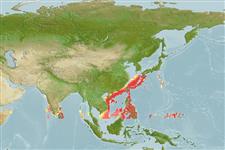Actinopterygii (ray-finned fishes) >
Scorpaeniformes (Scorpionfishes and flatheads) >
Scorpaenidae (Scorpionfishes or rockfishes) > Scorpaeninae
Etymology: Rhinopias: Greek, rhinos = nose + Greek, ops = appearance (Ref. 45335).
Environment / Climate / Range
Ecology
Marine; reef-associated; depth range 10 - 297 m (Ref. 90102). Tropical, preferred ?; 32°N - 6°N, 30°E - 155°E
Indo-West Pacific: South Africa (off Durban) east to southern Japan, the Caroline Islands, and eastern Australia.
Size / Weight / Age
Maturity: Lm ? range ? - ? cm
Max length : 23.0 cm TL male/unsexed; (Ref. 4313)
Dorsal
spines
(total): 12;
Dorsal
soft rays
(total): 9;
Anal
spines: 3;
Anal
soft rays: 5. Highly variable in color and in appendages in relation to habitat. Covered with appendages on algae reefs, but plain when deep with sponges (Ref. 48635). Body highly compressed and covered with weed-like tassels (Ref. 37816).
Found in rich soft-bottom habitats in current prone channels (Ref. 48635); also in rocky or coralline habitats near algae where it camouflages itself. Hunts prey at night like other species of scorpaenids, feeding on fish and small invertebrates. Solitary among corals, rocks and weeds (Ref 90102).
Life cycle and mating behavior
Maturity | Reproduction | Spawning | Eggs | Fecundity | Larvae
Myers, R.F., 1991. Micronesian reef fishes. Second Ed. Coral Graphics, Barrigada, Guam. 298 p. (Ref. 1602)
IUCN Red List Status (Ref. 115185)
CITES (Ref. 94142)
Not Evaluated
Human uses
Fisheries: of no interest; aquarium: commercial
More information
Common namesSynonymsMetabolismPredatorsEcotoxicologyReproductionMaturitySpawningFecundityEggsEgg development
ReferencesAquacultureAquaculture profileStrainsGeneticsAllele frequenciesHeritabilityDiseasesProcessingMass conversion
Tools
Special reports
Download XML
Internet sources
